Aviation against tanks (part of 17)
In 60, the construction of anti-tank helicopters in Europe was very limited, which was determined both by the imperfection of the helicopters themselves and by the low characteristics of the guided missile systems. The military were suspicious of chirping rotary-winged apparatus, which had a low speed, duration, and flight range. The relatively small capacity of the light-class helicopters did not allow to protect the cockpit and the most vulnerable units with armor, and to equip them with powerful weapons. In addition, the first guided anti-tank missiles, aimed at the target with the help of a hand joystick, were transmitted by thin-wire commands very strongly dependent on the skill of the guidance operator, and therefore were not particularly popular among the troops. Light helicopters were mainly used to deliver urgent correspondence, reconnaissance, adjust artillery fire and evacuate the wounded.
The first relatively effective anti-European helicopter can be considered the Aerospatiale SA.316В Alouette III, which in 1967 was equipped with the ARX-334 stabilized sight, the SACLOS semi-automatic targeting system and the improved Harpon anti-tank missiles AS.11.
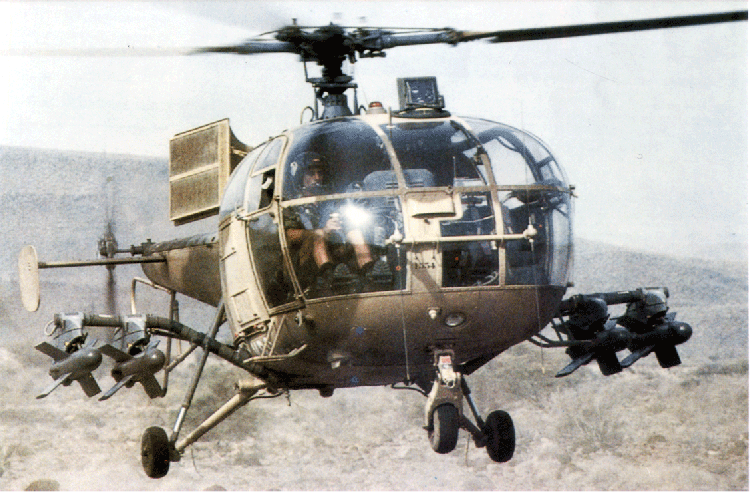
However, helicopters armed with rifle-caliber machine guns, 20-mm cannon and 68-70-mm NAR of French or American production were used much more often in combat. This was due to the fact that "Alueta", as a rule, were involved in various kinds of anti-partisan operations, against an adversary who does not have armored vehicles and with relatively weak air defense.
Aluet III III RAF combat helicopters in the 80s were used during the invasion of Angola. Faced with strong opposition in the form of MANPADS and anti-aircraft guns of the 12,7, 14,5, 23 and 57-mm caliber and Cuban MiG-23 fighters, the crews of South African helicopters were forced to act very carefully, but several Aluet crew were lost during the fighting. Although the operation of helicopters of this type in the South African Air Force continued until the 2006 year, already in the middle of the 80-x from their use as anti-tank refused.
Based on the SA.316 model, the SA.319 Alouette III was developed. With a maximum take-off weight of 2250 kg, this machine could take the payload of 750 kg. Turbomeca Art Turbos IIIB XB turbo engine could accelerate the helicopter to speed 570 km / h. Practical range of flight - up to 220 km.
Aluet III was popular with foreign buyers. On the basis of licensed copies in Yugoslavia and Romania, their own light anti-tank helicopters, armed with the Malyutka ATGM, 57-mm NAR C-5 and machine guns were created.
SA became a full-fledged light anti-tank helicopter. 342 Gazelle equipped with a gyro-stabilized sight ARX-334. This helicopter was created by the French company Aerospatiale together with the British Westland. The armament of the early anti-tank modifications SA 342 included: four AS.11-guided ATGM vehicles, two AS.12 air-to-ground missiles, two NAR containers of 68, 70 or 81 mm caliber, two rifle caliber machine guns or one GIAT caliber gun 20 mm. The 12 kg AS.76 rocket had a guidance system similar to AS.11. With a launch range of up to 7000 m, the rocket carried 28 kg semi-armor-piercing warhead. The main purpose of SD AS.12 was the destruction of stationary stationary ground targets and the fight against ships of small displacement. But if necessary, this missile could be used against armored vehicles or defeat of manpower. For this, replaceable cumulative and fragmentation warheads were delivered to the troops. This, however, does not mean that the range of the targeted launch on tank was larger than on AS.11 - a primitive guidance system at a distance of more than 3000 m gave too much error. On later models, the Gazelle’s armament was equipped with 4-6 HOT ATGMs with a gyro-stabilized sight ARX-379.
SA.342 Gazelle light anti-tank helicopter was developed based on the SA multi-purpose helicopter. 341 Gazelle. The helicopter differs from the predecessor of the Astazou XIV GTE with 640 kV capacity and two suspension nodes to accommodate weapons. Total built more 200 "Gazelle", equipped with an ATGM "Hot." The visiting card of the "Gazelle" of all modifications is the fenestron-type steering screw with a diameter of 0,695m, with rigid mounting of the blades. It is installed in the annular channel of the vertical tail unit.
Light combat "Gazelle" enjoyed success in the global arms market. At the end of the 70-x - the beginning of the 80-x in terms of price-quality ratio of competitors in this machine was not much. At the beginning of 80-x for a helicopter equipped with ATGM, they asked about $ 250 000. At the same time, the car possessed at that time sufficiently high flight data. Maximum flight speed was 310 km / h, cruising - 265 km / h. Combat radius of action - 280 km. By maneuverability, the Gazel exceeded the American Cobra and the Soviet Mi-24. However, in the French helicopter there was almost no armor, in connection with this, the pilots had to make combat missions in body armor and titanium helmets. But "Gazelle" with an anti-tank missile system from the very beginning was not considered as an attack aircraft. To combat the tanks has been developed appropriate tactics. After detecting enemy armored vehicles, the helicopter, taking advantage of the uneven terrain and natural shelters, had to secretly approach it, and after launching the ATGM as quickly as possible to retreat. The most optimal was a surprise attack due to the folds of the terrain with a short-term (on 20-30) lift for launching an ATGM and a hang-up at 20-25 m. The attack, as a rule, was to be carried out while being above the positions of its troops, and the elimination of such "wedges", or the attack of tanks moving on the march as part of the column, it was supposed to cause flank attacks.
The anti-tank missile system HOT (fr. Haut subsonique Optiquement teleguide tire d'un Tube - what can be translated as “A subsonic optical-guided missile launched from a pipe-container”), developed by the Franco-German consortium Euromissile, was put into service in 1975 year.
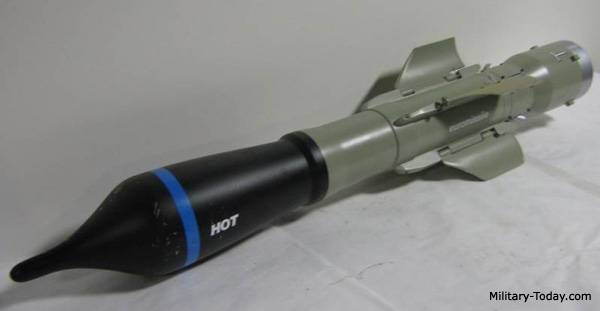
Storage and launch of anti-tank missiles, controlled by wire, made of fiberglass sealed container. Curb weight with ATGM - 29 kg. Missile launch mass - 23,5 kg. The maximum launch range is 4000 m. On an ATGM trajectory, it accelerates to 260 m / s. According to the manufacturer, a cumulative warhead with a mass of 5 kg is capable of penetrating 800 mm along normal lines into homogeneous armor, and at an encounter angle of 65 ° the thickness of the armor pierced is 300 mm. But in a number of sources, the claimed armor penetration characteristics are considered exaggerated.
In the process of pointing the missile, the operator must continuously keep the optical crosshair on the target, and the infrared tracking system displays the missile after launch to the aiming line. When the ATGM deviates from the line of sight, commands generated by the electronic equipment are transmitted by wire to the missile board. The received commands are decoded on board and transmitted to the device that controls the thrust vector. All operations aiming missiles at the target are made automatically.
The KHTK Hot was adopted in 19 countries. Since the start of mass production, about 85 000 missiles have been sold. According to the ATGM equipped with more than 700 combat helicopters. Since 1998, the construction of the variant designated HOT-3 has been underway. This modification, with a launch range of up to 4300 m, is equipped with a new noise-resistant bispectral tracking equipment and carries a tandem warhead with a laser fuse and a precharge to be fired, which provides an increase in the time delay between explosions of charges to overcome dynamic protection.
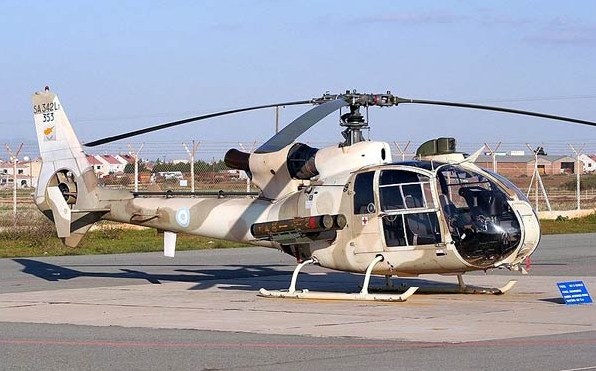
SA.342F Gazelle with four HOT missiles adopted in France in 1979 year. SA.342L modifications were delivered for export. The ATGM stabilized guidance system is equipped with a scope mounted above the cab. A modernized version of the Gazelle HOT / Viviane received a new HOT-3 ATGM.
Anti-tank "Gazelles" were in service in more than 30 countries, mainly in "developing". The baptism of the Iraqi SA.342L took place during the Iran-Iraq war. "Gazelle" in conjunction with the Mi-25 (export version of the Mi-24D) attacked the Iranian troops. But the tactics of the use of combat helicopters of Soviet and French production was different. The well-defended and faster MI-25 mainly provided fire support, firing at the enemy 57-mm unguided missiles C-5. Although the Phalanga and Hot Tank Systems had approximately the same launch ranges and missile flight speeds, the Iraqis liked the French complex’s guidance equipment more. In addition, the French ATGM had a great armor penetration. However, in a number of sources it is said that the “Hot” missiles of the first series had problems with reliability. Since SA.342 Gazelle was not covered with armor and could easily be hit even with small arms, the Gazelle crews tried to launch missiles whenever possible, being above the location of their own troops or over neutral territory outside the zone of enemy anti-aircraft guns.
In 1977, Syria signed a contract for the purchase of an 30 SA-342K Gazelle with the old AS-11 ATGM. In the 1979, the 16 SA-342L, equipped with HOT guided missiles and a perfect guidance system, was also obtained. As a result, to the 1982 war, the Syrians had a SA-342К / L helicopter brigade consisting of three squadrons.
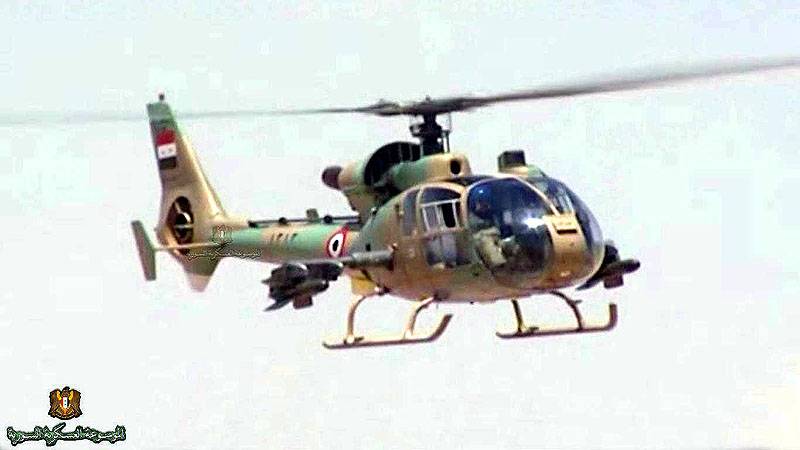
In the summer of 1982, the Israel Defense Forces launched Operation Peace of Galilee in Lebanon. The goal of the Israelis was to eliminate the PLO’s armed forces in southern Lebanon. At the same time, the Israeli command hoped that Syria would not intervene in hostilities. However, after parts of the regular Syrian army got involved in the conflict, the standoff between Israel and the Palestinians faded into the background.
The main task of the Syrian units, which in number were seriously inferior to the Israeli group, was the destruction of the advancing armored vehicles. The situation of the Israelis was complicated by the fact that the Israeli technology literally flooded most of the roads along which the offensive was carried out. Under these conditions, given the difficult terrain of the Gazel, armed with an ATGM, were almost perfect. Judging by the archival documents, the first attack of the link of anti-tank helicopters occurred on June 8 in the area of the Jebel Sheikh mountain. In a few days of fierce battles, according to Syrian data, the Gazelle, which made more than 100 combat missions, managed to knock out 95 units of Israeli vehicles, including the 71 tank. Other sources are more realistic figures: about 30 tanks, including the "Merkava", "5 magicians" and "sorcerers 6" BTR M5 113, 3 trucks, artillery pieces 2, 9 151 jeeps M5 and tankers. It is not known whether helicopters armed with AS-11 anti-tank guided missiles were used in combat operations or the entire Israeli vehicle was hit by Hot rockets. Despite their own losses, the Gazelle anti-tank helicopters in the 1982 war of the year, even against such a serious enemy as Israel, proved to be quite good.
In turn, the Israelis claim to 12 destroyed "Gazelle". The loss of four SA-342 has been documented. In this case, two helicopters made a forced landing on the territory occupied by Israeli troops, and subsequently were removed, restored and used in the Israeli Air Force.
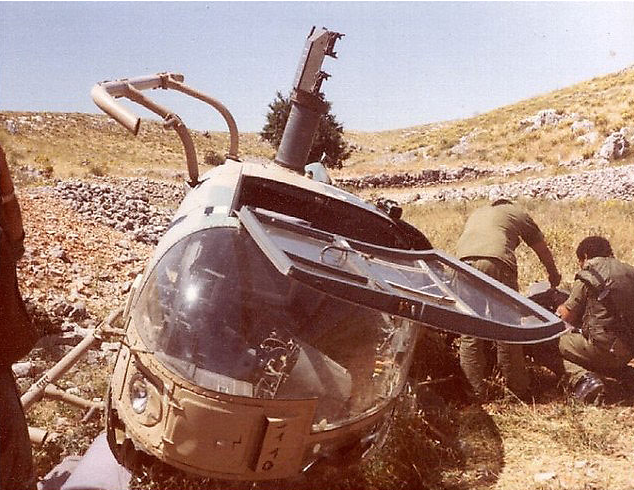
In this story combat use of "Gazelle" is not over. Syrian SA-342, despite their advanced age, were used during the civil war. Taking into account the addition of 1984 helicopters acquired in 15 year, as of 2012 year, approximately 30 machines remained in service.
In August 2014, a Syrian state television report reported that gazelles with anti-tank missiles participated in the defense of Tabka airbase. However, no details about their combat successes were not given. There is a high probability that the Syrian air force still has "Gazelles" in the flying state. In general, it can be stated that SA-342, purchased by Syria 40 years ago, was quite a good acquisition.
In the first half of 70, Yugoslavia purchased the first batch of SA.21Н helicopters from 341 in France. In the future, these helicopters were built under license at the company and the company SOKO on in Mostar (built 132 machines). In 1982, the serial assembly of the SA.342L modification (produced around 100 helicopters) began in Yugoslavia.
The launch of the infantry system “Baby” from an anti-tank helicopter “Gazelle” of Yugoslav production, the rocket control wire is clearly visible in the picture
Unlike the French Gazelles, the helicopters built in Yugoslavia were armed with four Soviet Malyutka anti-tank guided missiles. Compared with the AS.11 and LRT missiles, the Soviet ATGM was a simpler and more budgetary option. But "Baby" had a shorter launch range and worse armor penetration. In the 90-e years, "Gazelle" were used during the fighting in the territory of the former Yugoslavia, with several machines were shot down by MANPADS and anti-aircraft guns.
Along with the Soviet Mi-24 and the American “Cobra”, the anti-tank Gazelle helicopter became one of the most frequently used in combat operations. In 80, the Lebanese Air Force helicopters took an active part in the civil war. At about the same time, Moroccan SA-24L 342 fought with the armored vehicles of the Frente POLISARIO units. It is believed that the crews of the "Gazelle" in Western Sahara managed to destroy the 18 T-55 tanks and about three dozen vehicles. In 1990, France handed 9 SA.342 to the government of Rwanda. In 1992, during an inter-ethnic conflict, helicopters attacked the positions of the Rwanda Patriotic Front. On account of the Rwandan "Gazelle" there are lined tanks and armored vehicles. In October 1992, the crew of one helicopter during the attack of a convoy of armored vehicles of the PFR managed to destroy six armored vehicles.
Almost simultaneously with the French "Gazelle" in Germany, the Bo 105 helicopter was created by Messerschmitt-Bölkow-Blohm. Outwardly, with the exception of Fenestron, it was in many ways reminiscent of a Gazel. The helicopter is made according to a single-rotor scheme, with a tail rotor and a ski chassis. But unlike SA.342, it was a twin-engine machine with turboshaft GTE Allison 250-C20B with a take-off power of 313 kW. If one engine fails, the other one is transferred to emergency operation, which allows you to return to your airfield. Thanks to a more powerful power plant, the 105 could take a bigger load compared to the Gazelle, and the maximum take-off weight of the German car was more on 250 kg and was 2500 kg. Flight data of the German helicopter were quite high. Maximum speed - 270 km / h, cruising - 240 km / h. Combat radius of action - more than 300 km. Combat load - 456 kg.
First flight During 105, the 16 took place on February 1967 of the year, and the production of serial machines began with the 1970. The helicopter had a very good maneuverability, which was not slow to take advantage of the manufacturing company, advertising during 105 on aerospace showrooms. During the demonstration flights extremely lightweight cars, driven by experienced pilots, performed aerobatic maneuvers. It was noted that the West German helicopter has a high rate of climb, and the operational overload is 3,5G.
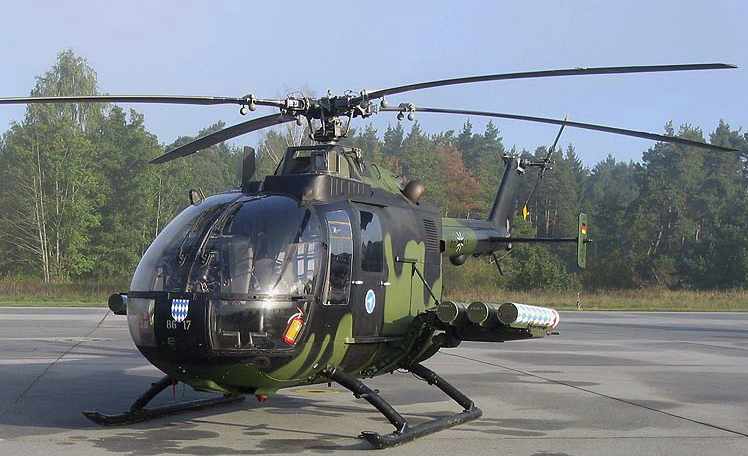
In 1975, the command of the Bundeswehr decided to order 212 anti-tank helicopters Bo 105 PAH-1 with an ATGM HOT. The upgraded anti-tank modification Bo 105 PAH-1А1 with ATGM NOT-2 was equipped with a French aiming-sight SLIM aiming system, with television and IR channels and a laser range finder. The most noticeable external difference in the upgraded version was the different arrangement of the ATGM plastic containers.
Beginning in 2007, the German anti-tank 105s began to be gradually replaced with the latest Tiger attack helicopters. Machines suitable for further use, disarmed, dismantling sighting and search equipment. The use of W 105 as reconnaissance and liaison in the armed forces of Germany continued until the 2016 year.
In addition to anti-tank guided missiles at the request of customers, 105-7,62-mm machine guns, 12,7-mm guns and NAR blocks are available for suspension on the 20. Deliveries of anti-tank helicopters were carried out from 1978 to 1984 year. At the end of the 80-ies, the cost of the Bo 105 PAH-1А1 anti-helicopter helicopter in the overseas market was $ 2 million.
The composition of weapons and avionics of export vehicles could be very different from the German version. Due to the fact that the ATGM NOT had problems with reliability, a number of foreign buyers preferred American TOW anti-tank missiles.
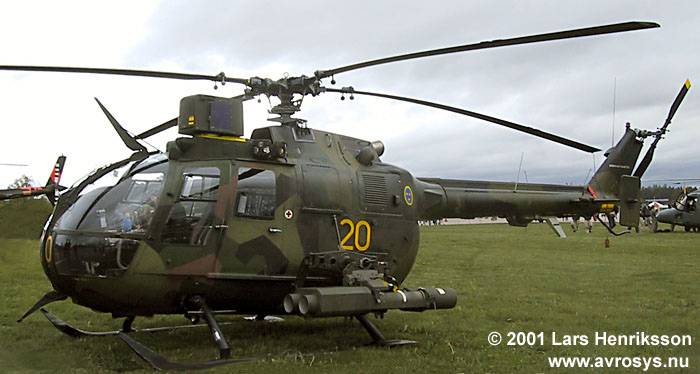
Although the armed versions of the 105 were delivered in two dozen countries, reliable information about the combat use of the helicopter could not be found. However, given the fact that Bo 105 was operated by the armed forces of such countries as Iraq, Sudan, Colombia, Peru and South Africa, it can be assumed that German-made helicopters still managed to make war.
In February, an 1991 Iraqi combat helicopter was shot down by an American A-10A attack aircraft. It is reliably known about the use of the Bo 105 Mexican Navy in operations to intercept high-speed boats on which drug traffickers delivered cocaine to the United States. South Korean combat helicopters, in turn, had fire contact with North Korean small vessels. The latest incident involving W 105 occurred in the Venezuelan capital city of Caracas 27 June 2017. Then the pilot of the stolen police helicopter attacked the building of the Supreme Court.
In the first post-war decades in the UK, little attention was paid to the creation of rotary-wing machines. Perhaps the only company that was seriously involved in helicopters in the United Kingdom was Westland. This company, founded in 1915, prior to renaming 1961 in the year Westland Helicopters created more than 20 models for various aircraft. In 60, Westland focused its efforts on the development and production of helicopters. At first, the licensed assembly of the American S-51 and S-55 developed by Sikorsky was carried out at the production facilities of the company. Soviet analogues of these machines can be considered Mi-1 and Mi-4. However, by the beginning of 60's, it became clear that piston-powered helicopters no longer meet modern requirements. Therefore, the specialists of the Westland design bureau in the city of Yeovil engaged in the development of a multi-purpose rotary-winged vehicle designed for transportation, evacuation of the wounded, reconnaissance and fire support. A helicopter with a crew of two people was supposed to provide transportation for seven paratroopers, at a cruising speed of at least 250 km. The range depending on the size of the payload 65 - 280 km. The development of a promising vehicle was seriously slowed down due to the participation of Westland specialists in the creation of the French-British Gazelle and Puma helicopters. At first, the design of the helicopter Lynx (English Rys) was also conducted in conjunction with the French company Aérospatiale. From the very beginning, two options were developed: naval and for ground forces. But in 1969, the French, quite satisfied with the Gazel, canceled the order for the attack reconnaissance helicopter. This affected the pace of work, and the first flight of the prototype took place on 21 March 1971 of the year. Tests "Lynx" were quite hard. Of the first four prototypes, two were severely damaged in flight accidents. Although, soon after the start of the test, a speed above 300 km / h was developed in horizontal flight, for a long time one of the main problems was a high level of vibration in flight at a speed over 100 km / h.
Multi-purpose helicopter Lynx AH.Mk 1 for the British Army took off 12 in April 1972. The power plant, consisting of a pair of Rolls-Royce Gem 2 turboshaft engines with an 900 horsepower rating, provided the maximum flight speed of 306 km / h. Cruising speed - 259 km / h.
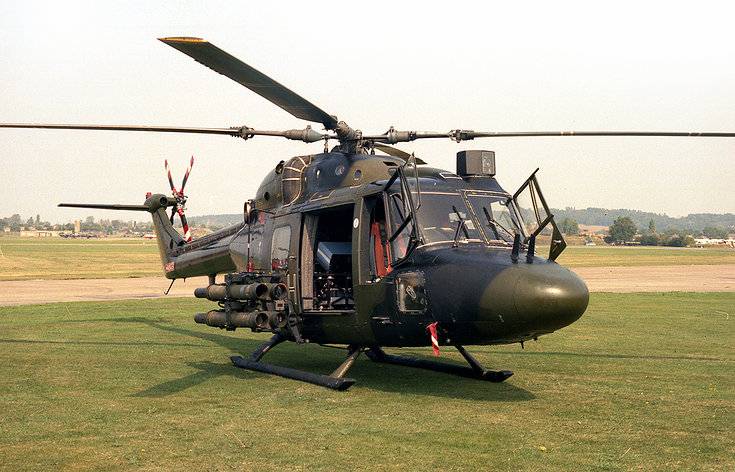
Although the appearance of the "Lynx" was quite ordinary, the helicopter had very good data and high modernization potential. The British managed to create a really very good transport and combat vehicle. A helicopter with a maximum take-off weight of 4535 kg could take the load on the 900 kg or transport the 1360 kg on an external suspension. The combat radius exceeded 300 km. The passenger compartment housed 9 soldiers with guns or 3 lying wounded with accompanying. In the shock version, the helicopter could carry two 20-mm cannons with a total 570 round of ammunition, 12,7 and 7,62-mm machine guns, two 68-70-mm NAR, 8 TOW or HOT units. Four ATGM launchers were located on the side of the cargo compartment, and the M71 American gyro-stabilized sight, to the left on the roof of the pilot's cockpit.
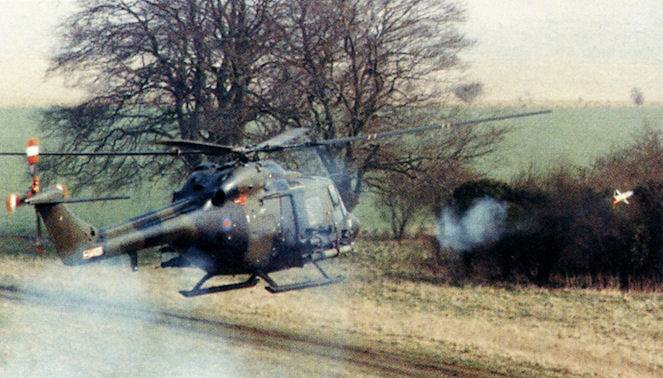
Operation of the anti-tank AH.Mk 1 in the British Army of the Rhine began in the summer of 1978. Soon the Lynx ousted all Scout AH.Mk 1, armed with AS.11 ATGM. A special feature of Lynx, armed with anti-tank missiles, was the transportation of spare ammunition inside the cargo compartment, which made it possible for the crew to quickly recharge.
In 1988, deliveries began to the troops of the Lynx AH.Mk 7 helicopter. The helicopter was equipped with two GTD Rolls-Royce Gem Mk 42-1 power 1120 HP and a new transmission. In this case, only 5 machines were built from scratch, the rest were altered from the previously released modifications. In the course of creating a modernized helicopter, much attention was paid to reducing the level of vibration and noise in the cabin. To do this, the AH.Mk 7 model was equipped with a damper for damping oscillations generated by the main rotor and changed the direction of rotation of the steering screw to the opposite. To reduce visibility in the infrared range, special diffusers were installed on the exhaust nozzles of the engine at the junction of the tail boom with the fuselage. Now the jet of hot exhaust gases was released into a larger volume of air, and their temperature was significantly reduced. The avionics included a sight-sight system with an infrared and television low-level camera. This significantly increased the combat capabilities of the helicopter during operations in bad weather and at night.
In 1989, the 2 squadron of the 9 airborne brigade began to enter the 24 th squadron Lynx AH.Mk 9. The main purpose of the AH Mk 9 is to fight the enemy armored vehicles. The distinctive feature of the AH Mk 9 was the use of new, more robust blades of the carrier system and a non-retractable wheeled chassis. A total of 16 new helicopters were built, and another 8 redone from AH Mk 7. As in the previous models, the main anti-tank caliber AH Mk 9 is the ATOW TOW. There are also several helicopters equipped with HOT-2 and Hellfire missiles.
The next modification was Lynx AH.9A with boosted engines LHTEC CTS800-4N with a capacity of 1362 hp. and with avionics helicopter AW159 Lynx Wildcat. Thanks to the increased thrust-to-weight ratio, flight data improved significantly, and the gauges were replaced by multifunctional color displays. The shipment of 22 AH.9A helicopters was completed in December 2011. In addition to the army aviation several vehicles entered the Navy for fire support of the Royal Marines. Of the approximately 470 built Linkes, only about 150 helicopters were intended for army aviation, and not all of them were equipped with ATGMs and sighting and search equipment. The bulk of the helicopters released in the marine version.
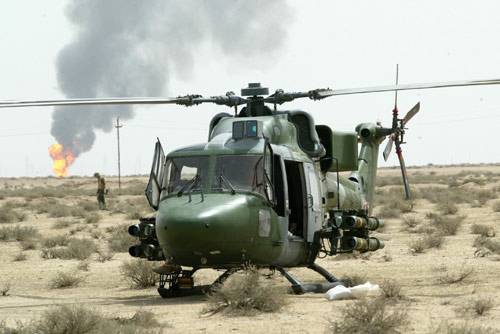
In 1991, British anti-tank "Lynxes" were involved in operations against Saddam Hussein's troops. According to British data, the company participated 24 helicopter. They operated in Kuwait and in the south of Iraq. Having made a little more than 100 combat missions, the Lynxes unmasked four T-55 tanks and two MT-LB armored tracked tractor with anti-tank missiles. In 2003, the Lynx AH.7 helicopters provided fire support to the coalition forces in Iraq, but their combat successes were not reported. 6 May 2006, the Lynx AH.7 with the number XZ6140 was hit by a MANPADS missile over Basra, according to other sources, the helicopter fell as a result of a rocket grenade fired from the RPG-7. In the same year, 2006 British Lynxes were deployed in Afghanistan. 26 April 2014, Lynx AH.9A under the number ZF540 crashed near Kandahar. All five people on board died, there is no reliable information about the reasons for the loss of the helicopter. During the fighting, the vulnerability of the Lynxes was revealed, even when fired from light weapons, which, however, was completely predictable for a helicopter that was not protected by armor.
On the whole, Lynx turned out to be a very good machine, and at the end of the 70-s, after eliminating the "children's sores", it looked very worthy in comparison with other universal transport-impact helicopters. The British car stood out for its high flight speed, good maneuverability, carrying capacity and flight range. But compared to the American UH-1, the German Woo 105, the French Aluet and the Gazelle, the British helicopter cost significantly more. For this reason, cramped customers chose lighter and less expensive cars as an anti-helicopter helicopter. Besides, it would be wrong to consider the unarmored Lynx as a full-fledged combat helicopter.
Until the second half of the 80s, there were actually two real combat helicopters in the world, with more or less balanced characteristics of firepower, security, speed and maneuverability: the Soviet Mi-24 and the American AN-1 Cobra. However, many countries felt the need for low-cost anti-helicopter helicopters, and therefore relatively light, weakly protected or unarmored vehicles were used in this role. In addition to the aforementioned “Aluet,” “Gazelle,” Woo 105 and Lynxes, Hughes Model 500 Defender was popular in pro-American countries. This light combat helicopter was designed on the basis of the civilian model Hughes 500, the prototype of which, in turn, was a light multi-purpose HE-6A Cayuse. “Keyus” was originally intended for reconnaissance, observation and artillery adjustment. The design of the helicopter draws attention to a large, drop-shaped double glass cabin, providing excellent visibility to the crew. To ensure the actions of special operations forces, some of the vehicles were converted into an armed version of the AH-6C. These helicopters carried six-barrel 7,62-mm machine guns and blocks 70-mm NAR.
Relatively inexpensive and very successful helicopters of the company "Hughes" enjoyed success in the market. For civilian buyers, the Hughes Model 500 was created, differing from OH-6 in the more powerful Allison 250-C18A engine with 317 l. with., increased fuel capacity and updated on-board equipment. On the basis of Hughes Model 500 built a light military helicopter Model 500D Defender (OH-6D Super Scout). His armament included four seven-shooter blocks 70-mm NAR caliber 70 mm or two eleven-charge blocks and two containers with six barreled M-134 machine guns of the caliber 7,62-mm or 40-mm grenade launchers. Maximum payload - 430 kg. In another variant of the combat load, missile launchers were placed on one side, and on the other was a container with an 12,7-mm machine gun or 20-mm cannon. The placement of significant armament on the external sling caused a noticeable drop in flight data — the speed and range of the flight. Therefore, in the standard version, the armament was placed on only two external nodes.
The internal volume of the Defender cab was very limited, which prevented the installation of ATGM guidance equipment, and the capacity of the helicopter itself did not allow the simultaneous use of NAR, machine-gun artillery weapons and guided anti-tank missiles. In 1976, a modification of the Model 500 TOW Defender appeared, an American gyro-stabilized M65 sight was mounted on the outer nose of the cabin, and four ATGM TOW on the outer nodes.
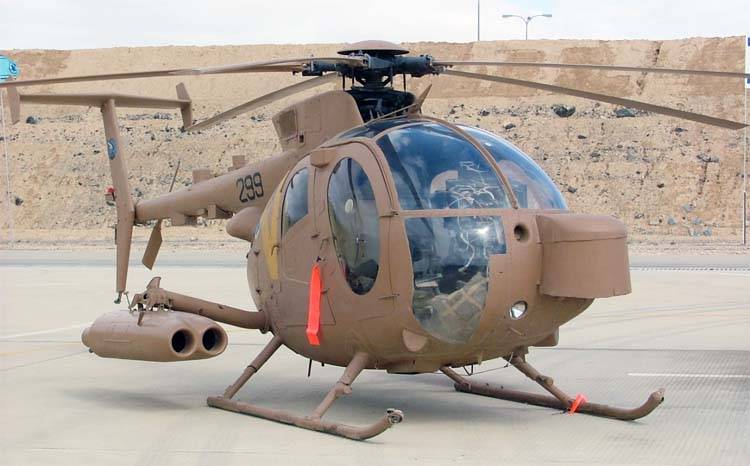
A helicopter with a maximum take-off weight of 1360 kg could develop in horizontal flight - 257 km / h. Cruising speed - 236 km / h. The combat radius for a car of this class was very significant - more than 300 km. The helicopter was very easy to drive and had excellent maneuverability and high rate of climb (8,5 m / s). The lack of armor was partly compensated by the small geometrical dimensions and maneuverability characteristics. When used in the antitank variant, the effectiveness of the Defender was close to the Cobra armed with the Tou ATGM. At the same time, the Model 500 TOW Defender was worth two times less and predictably interested foreign customers. A total of about 500 helicopters were built, but how many of them in the anti-tank variant are not known.
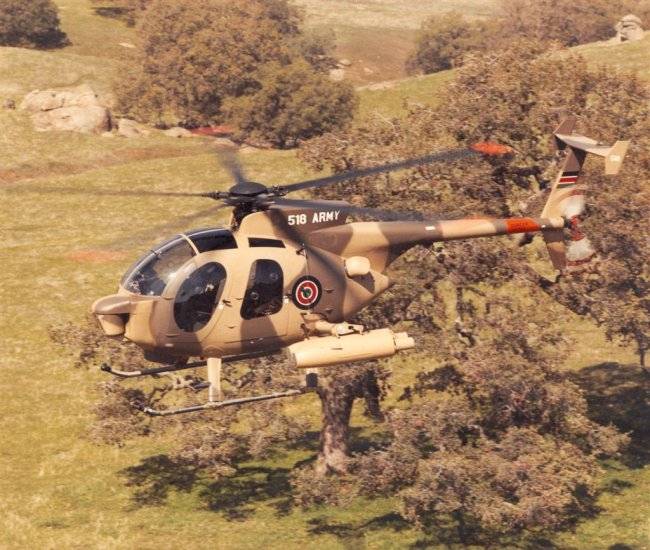
Armed modifications of Model 500 helicopters were used in a number of local wars. The most ambitious conflict where Defender was used with an ATGM was the Israeli 1982 summer campaign of the year. Three dozen Model 500 TOW Defender were received by the Israeli Air Force in 1979 year. By 1982, Israeli crews mastered their combat vehicles well. Israeli anti-defenders were used against Syrian armored vehicles along with the AH-1S, which were better protected from anti-aircraft fire. By the outbreak of hostilities in the Israeli Air Force "Defender", equipped with anti-tank systems, it was almost two times more than the "Cobra".
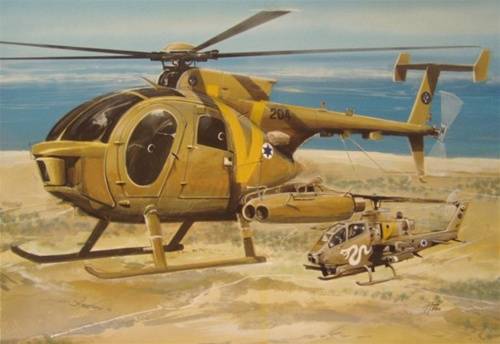
Crews of Israeli military helicopters declared the defeat of 50 tanks, infantry fighting vehicles and armored personnel carriers. In this case, more than 130 sorties were made. Unfortunately, there is no data on the effectiveness of attacks of each specific type of combat helicopter. In addition, it is not clear whether Israeli statistics take into account only hits or whether we are talking about irretrievably destroyed armored vehicles. It is known that during the battles in Lebanon there were cases of ATU “Tou” getting into the frontal projection of the Syrian T-72 tanks, but the frontal armor was not pierced.
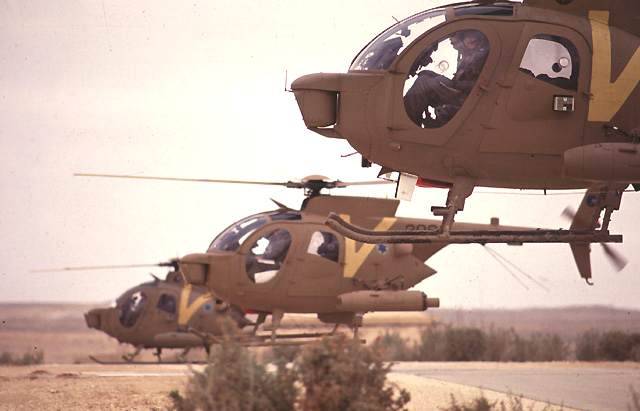
During the fighting, both the strengths and weaknesses of the Defenders were revealed. Thanks to better maneuverability, light helicopters were faster than armored "Cobras" occupied the line of attack. Compared with the Cobra, flights at extremely low altitudes with rounding irregularities in the terrain on the Defender were made much easier. Also, a lighter helicopter was easier controlled in a hover mode or when maneuvering at low speed. Defender was free to move sideways and back. It was noted that the time and cost of preparing the Model 500 for re-departure is much less. At the same time, a high vulnerability to combat damage was revealed. The lack of armor and special measures to increase combat survivability affected the level of combat losses. Although there is no reliable information about the number of "Defenders" lost during the hostilities, after 1982, 6 machines were additionally purchased. Apparently, the reasons for the losses of the Model 500 TOW Defender in the Israeli Air Force were not only the actions of the Syrian defense. Due to some external similarity between the “Defender” and the “Gazelle”, tankers and calculations of anti-aircraft installations of the units that had previously been attacked by Syrian anti-tank helicopters launched “friendly fire” against Israeli helicopters. So, the Israeli defender was badly damaged by a fragmentation shell fired from a Merkava tank gun. The shell exploded, hitting the rock, near which the pinwheel hung. At the same time, the ATGM operator was wounded, and the helicopter made an emergency landing next to the tank that had shot it down. Nevertheless, Defender confirmed its ability to successfully operate as an anti-tank helicopter. As is known, the Israelis are very scrupulous in the selection of military equipment and weapons, and immediately get rid of samples that have proven negative in combat. To "Defender", apparently, this does not apply, helicopters of this type were removed from service in Israel only in 1997 year.
In August, 1985, in connection with the purchase of McDonnell Douglas Corporation by Hughes Helicopters, the designation of the helicopter Model 500 was changed to MD 500. McDonnell Douglas conducted a fairly aggressive marketing policy, selling helicopters through intermediaries to countries where there were internal armed conflicts or unresolved territorial disputes with neighbors. Often, MD 500 without weapons was supplied as purely civilian vehicles and was armed on the spot. Re-export MD 500 spread around the world and participated in a variety of "low intensity" conflicts. This is especially true in Africa, Asia, South and Central America. So, in El Salvador, 6 MD 500D and 9 MD 500E acted against the rebels. Several helicopters were shot down by small arms and Strela-2M. By the time of the conclusion of a truce between the government and the rebels, 7 helicopters remained in the ranks.
In 1986, the DPRK, through several intermediaries, it was possible to purchase 87 unarmed MD 500. Initially, helicopters were used as liaison, reconnaissance and surveillance. Since the MD 500 is used by the South Korean armed forces, South Korean insignia and camouflage were put on several helicopters, after which they were used to throw saboteurs.
According to South Korean data, around 60 North Korean MD 500E are equipped with the “Malyutka” ATGM. Although outdated Soviet missiles are inferior in terms of launch range and thickness of armor pierced by the latest versions of the Tou ATGM, there are no other specialized combat helicopters in North Korea.
MD 500, armed with anti-tank missiles, were demonstrated at a military parade in the 2013 year. Apparently, much of the North Korean MD 500 is still in flight. This is facilitated by the relatively simple design of the helicopter and the availability of spare parts on the world market.
Despite the fact that the first flight of the Hughes Model 500 took place in February of the 1963 year, the improvement and creation of new military models continues to this day. Based on the modifications of the MD 520 and MD 530, several impact versions have been created, differing in the power plant, avionics and armament composition.
The MD 530 Defender helicopter with a maximum take-off weight of 1610 kg is equipped with a new Allison 250-C30B engine with an 650 hp power. Maximum flight speed - 282 km / h, cruising - 230 km / h. Payload weight increased to 900 kg. At the request of the customer on the helicopter can be installed equipment that allows you to make combat missions at night. This modification is known as MD 530 NightFox.
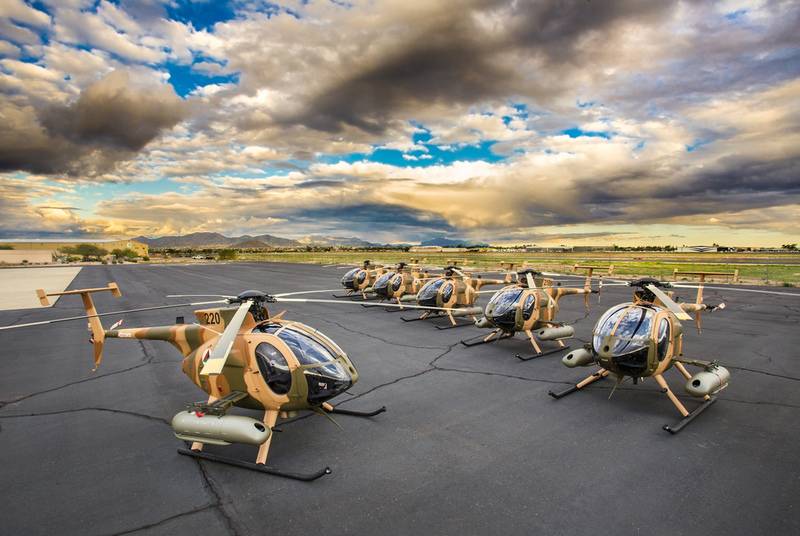
Currently being mass production modifications MD 530F Cayuse Warrior. In August, the 2016 of the first four helicopters of this type, designed for the Afghan Air Force, were delivered by C-17 Globemaster III military transport aircraft. The initial order provides for the delivery of 24 helicopters, just over the next 5 years, the Afghan Air Force should receive 48 lightweight strike vehicles. Since the Taliban do not have armored vehicles, in the basic configuration for the Afghan Air Force MD 530F Cayuse Warrior is armed with NAR units and HMP400 suspended machine gun containers produced by the Belgian company FN with 12,7-mm machine guns (1100 fired fire / amyour combat unit / minute, in the case of the 400 firing unit / min. If necessary, the helicopter can be quickly armed with ATGM TOW.
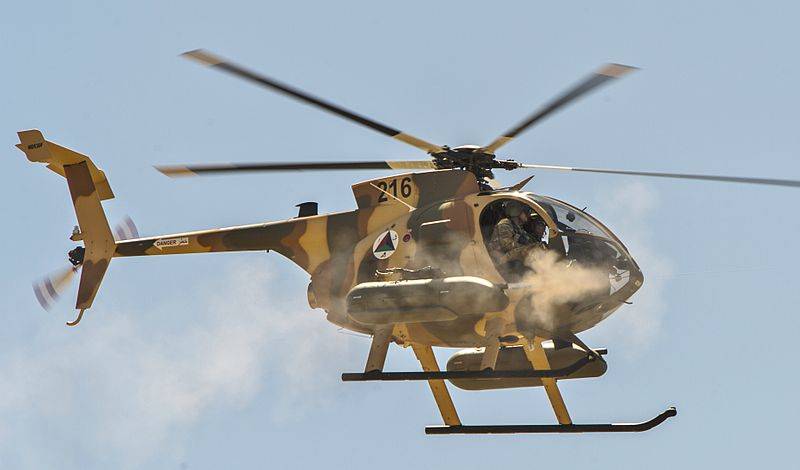
The pilots have satellite navigation equipment, modern communications and night vision goggles. To reduce the vulnerability during shelling from the ground, the cabin and part of the units have a local reservation. Fuel tanks with a total capacity of 500 l are secured and withstand a chamber with 12,7-mm bullets.
To support the US Special Operations Forces, an AH-6 Little Bird combat helicopter was created. This miniature highly maneuverable machine took part in many secret operations around the world, and in some cases was a “lifeline” for special forces operating in enemy territory. Despite its modest size, the effectiveness of the "Little Bird" under the control of a well-trained crew can be very high.
The helicopter was put into service in the 1980 year, as a modification of the OH-6 Cayuse and has been actively used since its inception. The choice of this particular model is due to the fact that the size and weight of the machine makes it easy to transport it to its destination by US Air Force transport aircraft. In the aviation division of special operations forces, a light combat helicopter was tested, with a nadvtulochnaya search and survey night optoelectronic system. With it, the helicopter could conduct a review and search for targets in hover mode, hiding behind treetops, buildings or natural elevations.
AH-6 Little Bird helicopters are in service with the 160 Aviation Regiment of the United States Land Forces (also known as Night Stalkers - Russian. Nighttime Persecutors), and in the FBI's elite anti-terrorist special forces. AH-6С received a baptism of fire in 1983, during the invasion of the US armed forces in Grenada. In operation "Outbreak of Fury" was involved a half dozen small, nimble machines, based on Barbados. Several "Little Birds" supported the actions of the "contras" in Nicaragua. In 1989, helicopters of the 160 regiment took part in the Right Cause operation in Panama. In 1993, the AH-6 F / G provided fire support to the soldiers of the 1 Special Operations Regiment of the United States Army Delta Force in Mogadishu, the capital of Somalia. In 2009, several “Little Birds” were deployed in Somalia during the operation to eliminate the terrorist Saleh Ali Nabhani. Little Bird participated in special operations in Iraq, beginning with the US and British coalition forces invading 2003 there. It is reported that when providing fire support to ground forces, “laser-guided light missiles” were used. Perhaps we are talking about modified missiles Hydra 70.
The most advanced version used by the US Special Operations Forces AH-6M is based on the helicopters of the commercial series MD 530. AH-6M introduced numerous innovations: the Allison 250-C30B engine with 650 power HP, six-blade main rotor with increased efficiency, withstand a chamber 14,5-mm bullets, composite armor, an improved navigation system based on GPS, infrared equipment FLIR.
The helicopter is equipped with an advanced weapon control system, which makes it possible to use AGM-114 Hellfire anti-tank guided missile systems with a laser seeker. In 2009, it was reported that Boeing, within the framework of the ARH program (Armed Aerial Scout - Russian Light Armed Scout), was operating a combat helicopter AH-6S Phoenix. Through the use of the engine Rolls-Royce 250-CE30 680 horsepower. the helicopter's payload is 1100 kg.
On the basis of AH-6S by order of Saudi Arabia, Boeing Corporation has created a light combat helicopter AH-6I (International). The cost of the first batch of 24 machines, intended for the Saudis, is $ 235 million, excluding weapons.
In addition to anti-tank and fire support helicopters, an unmanned version of the AN-500X was developed by Boeing based on the Hughes Model 6. Initially, the main task of a light unmanned helicopter should have been the evacuation of the wounded. But later, given the available number of Keyuys, Defenders and Little Birds with a resource close to the limit, it was considered rational to convert these vehicles into unmanned combat helicopters. The program received the designation ULB (Unmanned Little Bird - Russian. Unmanned Little Bird). It is reported that technical solutions and control equipment tested on the AN-6X can be used on other combat helicopters, including the AN-1 Cobra and AH-64 Apache.
To be continued ...
Based on:
http://www.military-today.com/missiles/hot.htm
http://dimitrijeostojic.com/blog/pasuljanske-livade-live-firing/
http://www.indiandefensenews.in/2016/06/idn-take-hal-lch-vs-changhe-z-10.html
https://bmpd.livejournal.com/1542431.html
https://fas.org/man/dod-101/sys/ac/row/bo105.htm
https://www.dstorm.eu/pages/loadout/lynx.html
http://www.arms.ru/stati/avia/zarubezhnye/westland-lynx-ah-mk-9.htm
http://www.aeroflight.co.uk/waf/aa-mideast/israel/af/israel-af-all-time.htm
https://www.mdhelicopters.com/md-530f-armed.html
- Linnik Sergey
- Aviation against tanks (part of 1)
Aviation against tanks (part of 2)
Aviation against tanks (part of 3)
Aviation against tanks (part of 4)
Aviation against tanks (part of 5)
Aviation against tanks (part of 6)
Aviation against tanks (part of 7)
Aviation against tanks (part of 8)
Aviation against tanks (part of 9)
Aviation against tanks (part of 10)
Aviation against tanks (part of 11)
Aviation against tanks (part of 12)
Aviation against tanks (part of 13)
Aviation against tanks (part of 14)
Aviation against tanks (part of 15)
Aviation against tanks (part of 16)
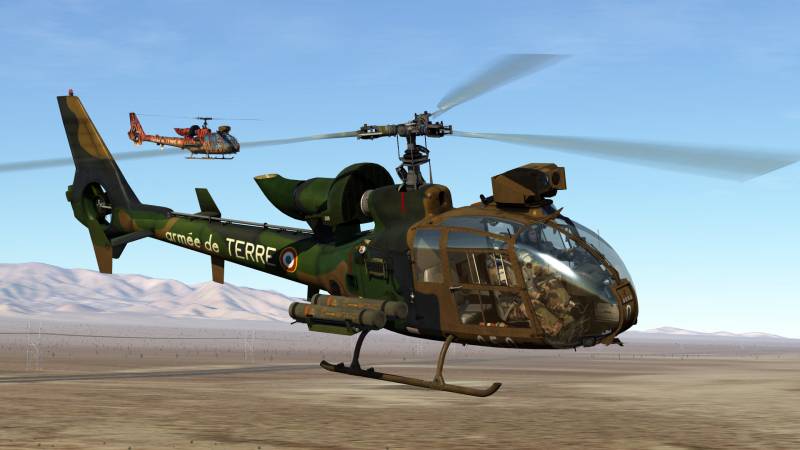
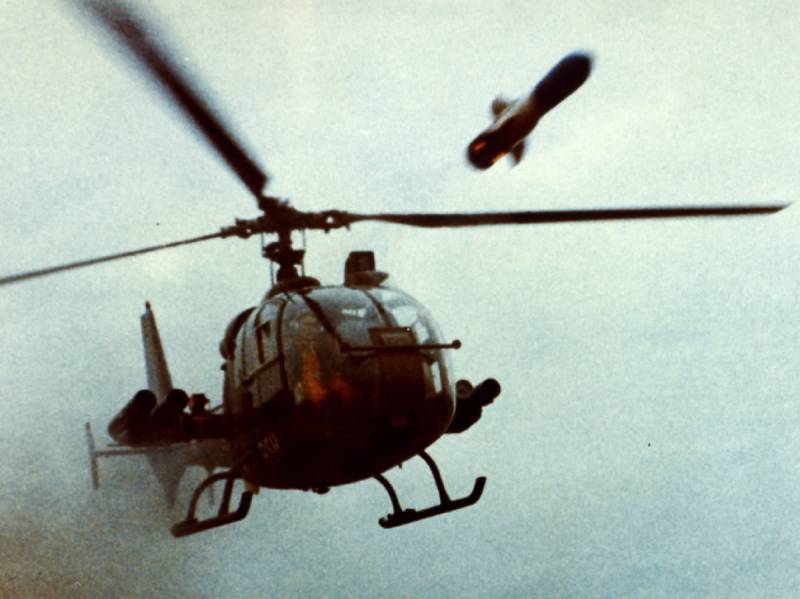
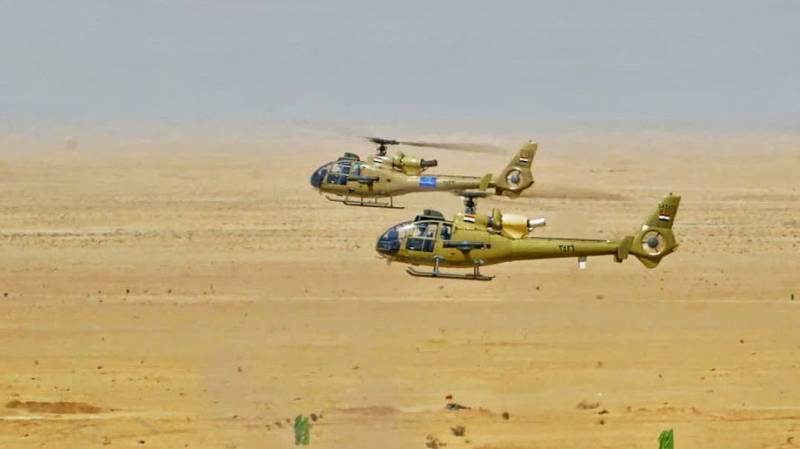
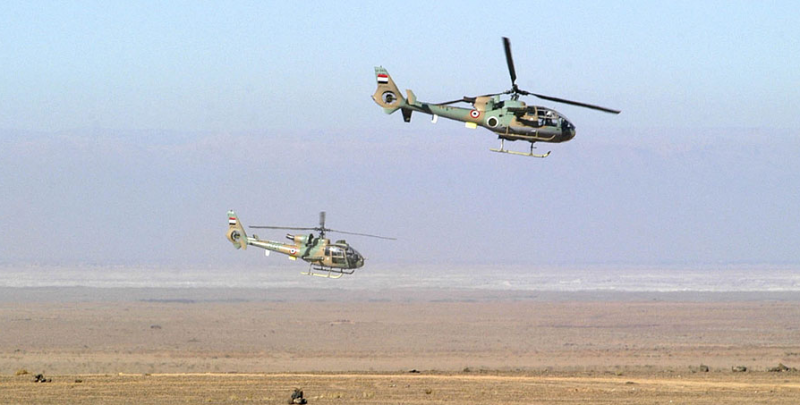
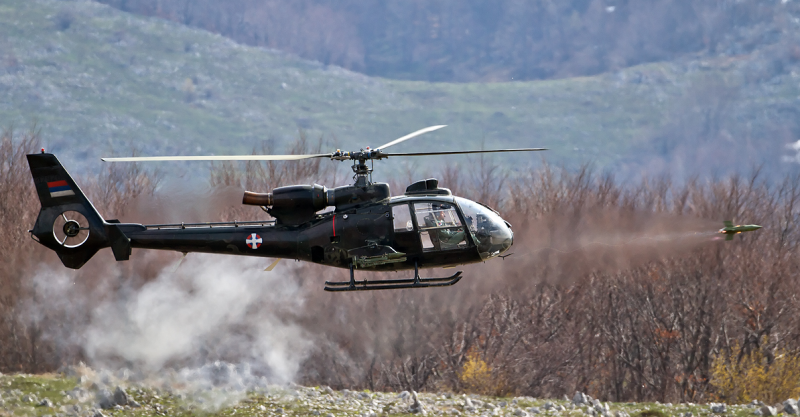
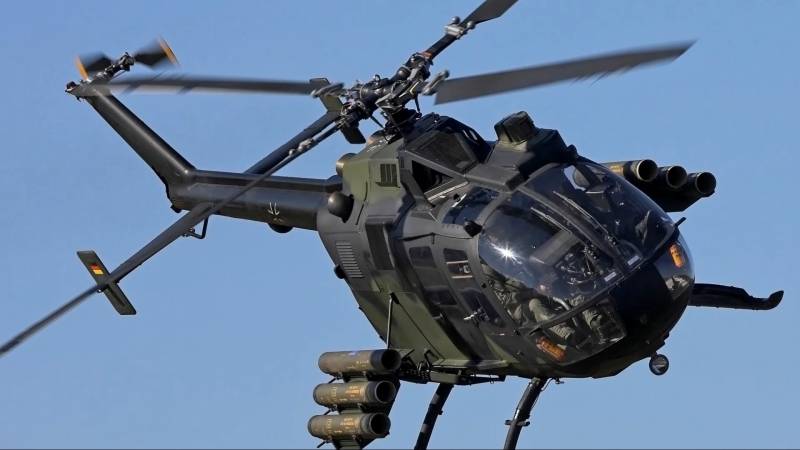
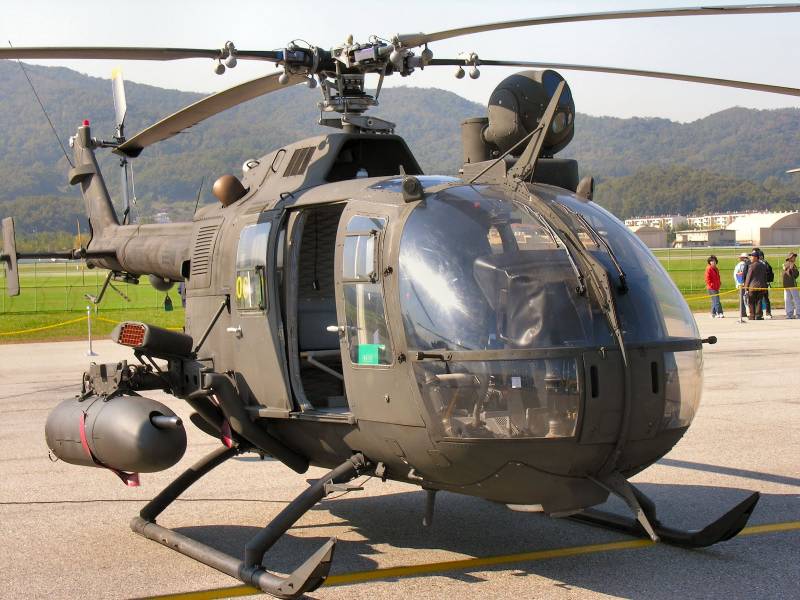
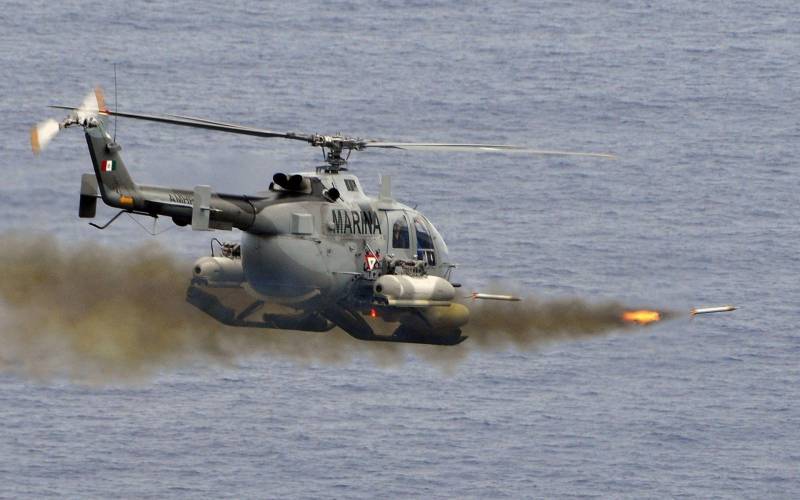
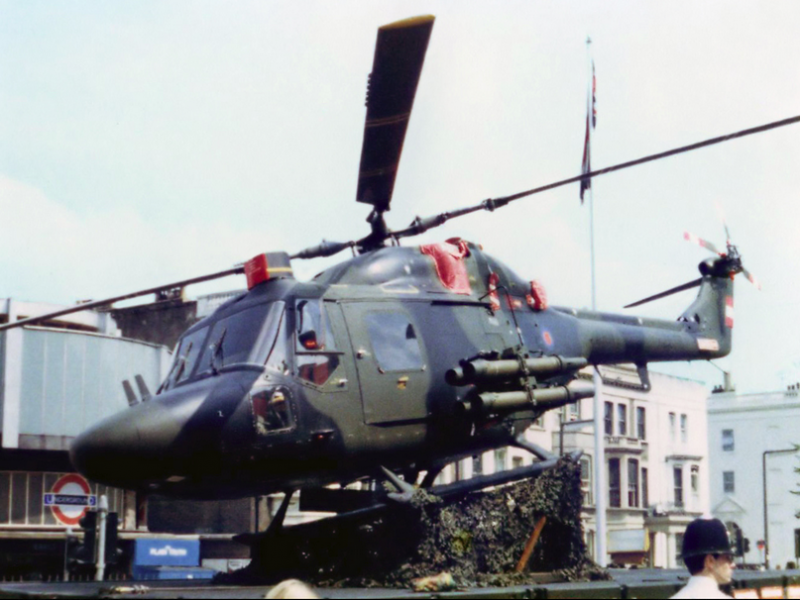
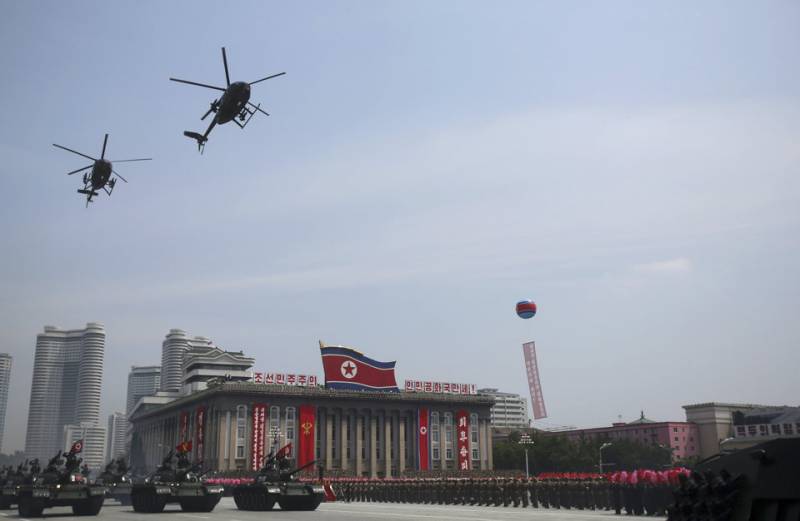
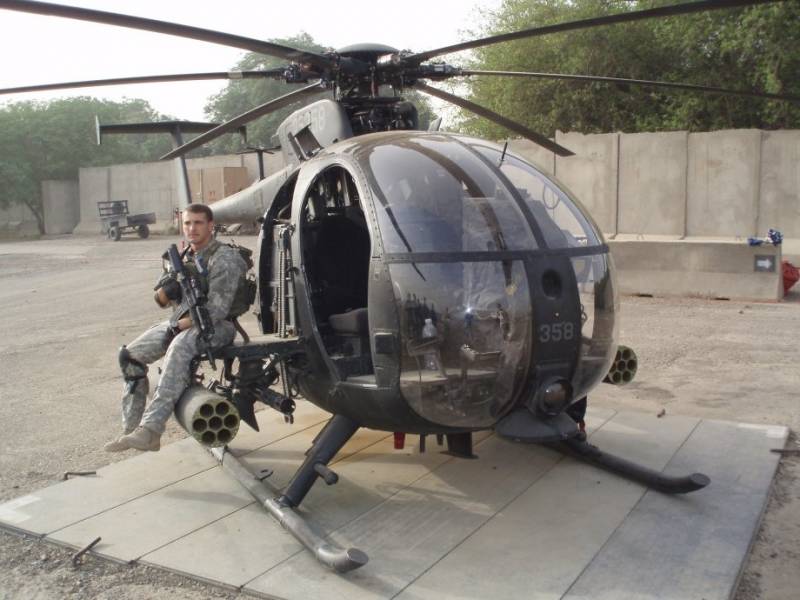
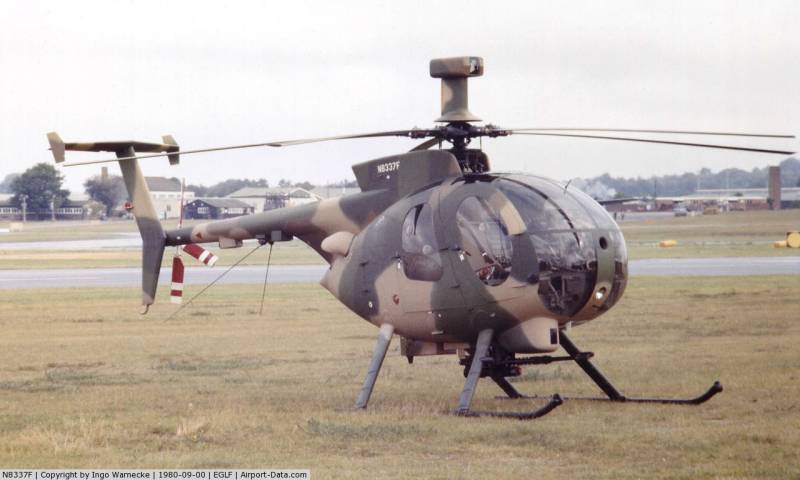
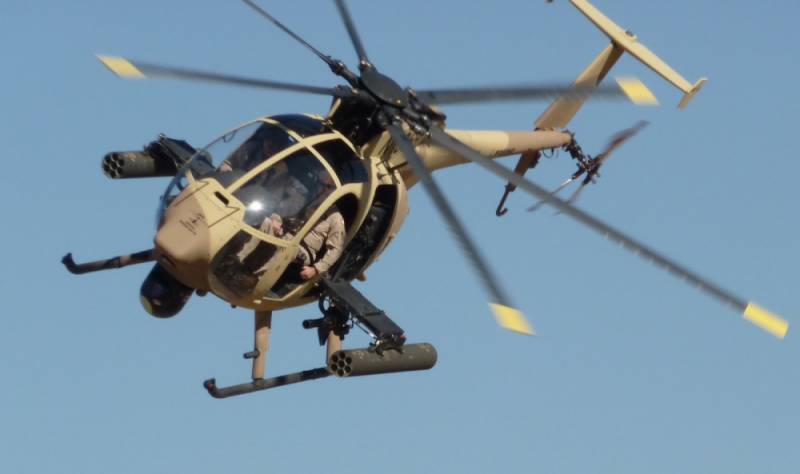
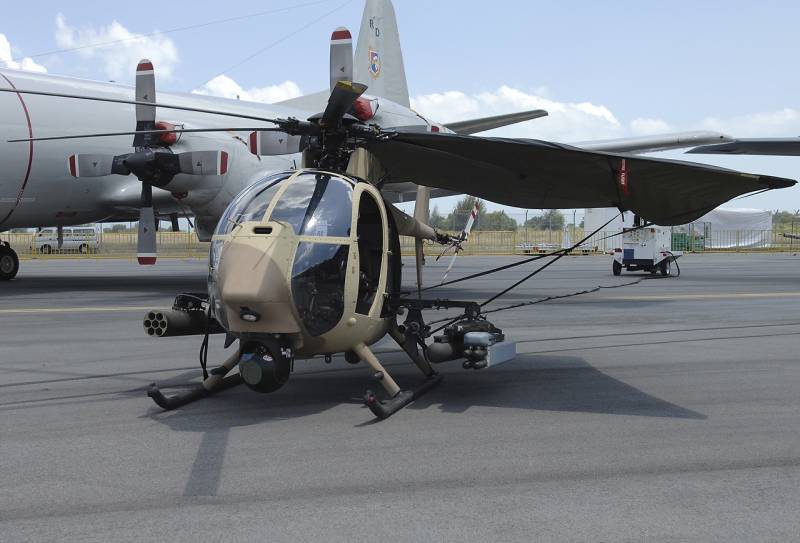
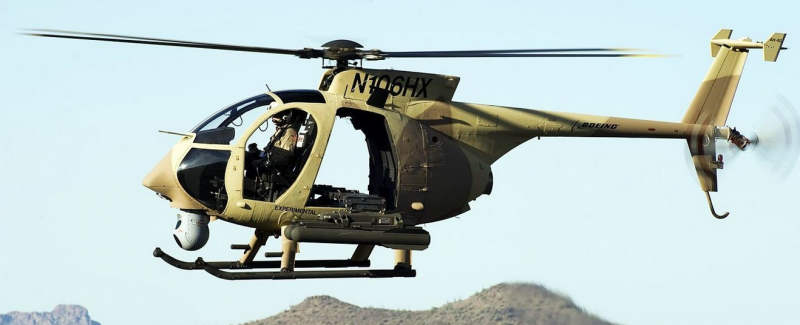
Information